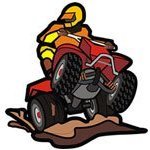Yamaha Bruin 350
-
Similar Forum Topics
-
By ATVNetwork
As the 2025 ATV Motocross National Championship Series (ATVMX), an AMA National Championship, got underway with back-to-back Florida AMA Pro only events, it was evident that Phoenix Racing Yamaha’s Joel Hetrick picked up where he left off last season.View the full article
-
By Kaz
Troubleshooting a no spark issue, was running OK, maybe a little rich, turned it off, now no spark. I've checked/ohmed out the main key switch, the start/stop switch, neutral switch, brake switch - all good. It will crank the starter, but no spark with the starter or when I try the pull start. I've checked all fuses and diodes. Swapped battery. New plug. New coil. Swapped in a used CDI - no help. Traced, removed, cleaned, reattached all grounds. Removed things like my winch from the circuits to be sure a bad relay or something was dragging it down. When testing voltages, the orange wire going from the CDI to the ignition coil shows no/very low voltage-shouldn't it have 12V on it? Sometimes I get a very weak, intermittent glow on my spark tester, but not enough to fire the plug. I've checked continuity on just about all wires in the harness. Checked/cleaned/lubed w dielectric grease- all connections, redid a few that looked old/dirty. I've checked the stator resistances, all good, but have a stator and rectifier ordered anyway, will arrive Sunday. I verified that the rectifier has a voltage output back to charge the battery while cranking - 10.5-11V, low, but expected while starter is engaged. What else can I check as part of troubleshooting? I have a Haines service manual, but the 1999 350 4x4 seems to be an odd model, there isn't an exact electrical diagram for it, but found one for another year that has all the same number of wires and same color wires, so I've referenced that. Any hints, tips or advice would be appreciated! Thanks!
-
By P_syko
I’m brand new to 4 wheelers and just bought a 1987 Yamaha Moto 4 350. It has good compression and fuel, but no spark. I’ve looked high and low trying to find how to test all the components of the ignition system, but can’t find anything. This has a new CDI box on it, but I suspect it might be the stator. How do I test the stator on this? Any help would be greatly appreciated!
-
By oxidized_black
View File 1988-2002 Kawasaki Bayou 220 service manual
Also available on eManualOnline
1988-2002 Kawasaki Bayou 220 service manual
The Kawasaki Bayou 220 is one of the most common all-terrain vehicles on off-road trails that is geared toward novice riders and families. It’s also one of the smallest and most inexpensive ATVs on the market, with a retail price under $3,500, as of 2010. The Bayou 220 is Kawasaki’s only ATV of its size. The 220’s sibling is the larger Bayou 250 equipped with a 228cc engine.
Engine
The Bayou 220’s engine is a 215cc, four-stroke, shaft-driven, air-cooled model. Its bore measures 2.6 inches and the stroke is 2.4 inches. It features a relatively high 9.3:1 compression ratio with fuel delivered through a Mikuni VM24SS carburetor. The electronic ignition is Kawasaki’s DC-CDI. It also features a recoil backup as a starting system. The clutch is an automatic wet multidisc model with power delivered to the wheels via a five-speed transmission, according to ATV Source.
Chassis
The steel frame supports a front suspension with single A-arms and twin shock absorbers, with the rear suspension a Quad-Link system with two shocks. Front wheel travel is 4.5 inches, while the rear wheel travel measures at 4.9 inches. Front and rear brakes are drums.
Size
The front tire size is AT21X8-9 with the rear tires measuring AT22X10-10. The ATV’s wheelbase is 43.9 inches, with an overall length of 68.7 inches. Ground clearance is 6.1 inches with the seat height measuring 28.7 inches. It weighs 403 lbs. and can tow up to 450 lbs. Its fuel tank can carry 2.6 gallons.
Basics
The Kawasaki Bayou 220 is not the fastest ATV on the market, but one reason the Bayou 220 has kept its price low is the lack of amenities. It features a brake light and dual headlamps with high/low beam. There is an auxiliary lighting terminal inside the front cover of the ATV and electrical accessory terminals under the seat. The instrument cluster atop the fuel tank features a fuel gauge, but not much else. There are no speedometer, odometer, hourmeter, tripmeter, high-beam indication or high-temperature light. It does have a reverse/neutral indicator light. The Bayou comes in two colors: hunter green and firecracker red.
Features
The front A-arm, twin shock and rear Quad-Link twin-shock suspension system is not a true fully independent system, but it allows for a comfortable ride over rough terrain without employing a complex and expensive, fully independent suspension system. The ATV features front and rear steel cargo racks. The ATV is rider-friendly with a limited adjustable throttle to help novices practice their riding skills without twisting the throttle too far and losing control of the vehicle.
Submitter oxidized_black Submitted 12/14/2016 Category Kawasaki ATV
-
-
By P_syko
Does the 1987 moto 4 350 have a low oil sensor that kills spark? Or are these too old for that kind of thing?
-






Recommended Posts
Join the conversation
You can post now and register later. If you have an account, sign in now to post with your account.
Note: Your post will require moderator approval before it will be visible.